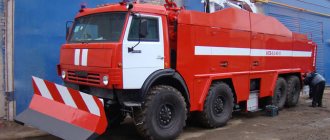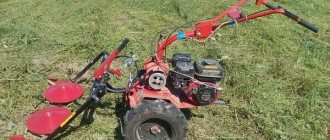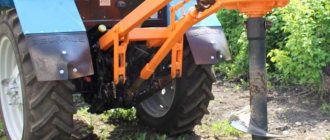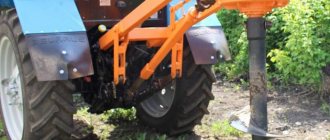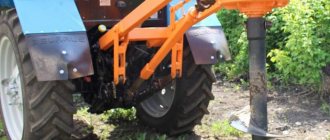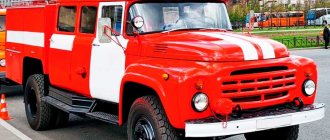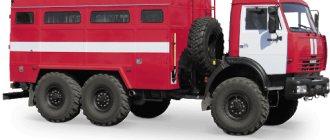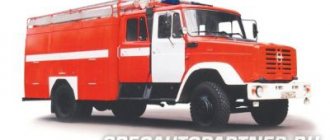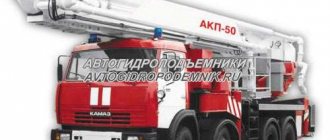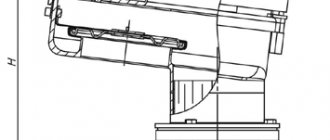General information
For many years, the ZIL plant was the largest manufacturer of trucks in the USSR. The plant produced two types of trucks - ZIL-130 with rear-wheel drive and ZIL-131 with all-wheel drive. It was these two chassis that were most often used to create special equipment.
It should be noted that the rear-wheel drive chassis was used to build tank cars, and the more stable and versatile all-wheel drive chassis was used for retractable car ladders.
Fire tankers are designed not only to extinguish fires in various conditions, but also serve to deliver fire crews. On board the machine there is a supply of water and foaming agent, as well as a pumping unit with the ability to supply water from open reservoirs.
Specifications
Technical characteristics of the fire engine ATs-40-63B:
- Engine power - 110 hp. With.
- The maximum driving speed is 90 km/h.
- The length of the pressure hoses is 348 m.
- The area for extinguishing with medium expansion foam is 83 m².
- Pump capacity - 40 l/s.
- Head - 100 m.
- Number of hand barrels - 6 pcs.
- Supply of pressure hoses - 18 pcs.
- Fuel tank - 150 l.
- Fuel consumption per 100 km - 41.5 liters.
Dimensions:
- length - 7680 mm;
- width - 2500 mm;
- height - 2780 mm.
Performance characteristics (TTX) of ZIL-131:
- Tank volume - 2400 l.
- Foam tank capacity - 150 l.
- Engine power - 150 hp. With.
- The highest speed is 80 km/h.
- Fuel tank capacity - 170 l.
- Extinguishing volume - 125 m³.
- Pump flow - 40 l/s.
- Head - 100 m.
- Water flow in the fire monitor is 19 l/s.
- Fuel consumption per 100 km - 40 liters.
Among the transportability parameters of the AC-40(131)-137, the height stands out, which, without taking into account the combat crew, water and foaming agent in the transport position, reaches 2950 mm.
How much does it weigh
The weight of a firefighting ZIL with a full load is 9.6 tons. Taking into account the add-ons of fire-fighting equipment, the total weight reaches 11 tons.
Tank vehicles ATs30(130)63
The first version of the fire truck on the new ZIL-130 chassis appeared in mass production in the fall of 1965. The development and production of the vehicle under the designation PMZ 63 was carried out by the Priluki Fire-Fighting Equipment Plant. After some time, in accordance with the new designation system, the car was renamed ATs30(130)63. In the vehicle index, the letters AC indicated the tank truck, 30 - the power of the installed pump in liters per second, 130 - the type of base chassis and 63 - the type of model. Subsequently, factories in Orekhovo and Losino-Petrovsky began producing cars with the same designation.
The combat crew of the vehicle consisted of seven people, including the driver. The transportable supply of water in the tank is 2100 liters, the supply of foaming composition is 150 liters. The tank trucks were equipped with a portable motor pump MP 800A, a three-legged ladder and other equipment. Water pressure was provided using a pump model PN 30KF with a capacity of 30 l/sec., However, there are machines of later production with a pump with a capacity of 40 l/sec. This was the AC30(130)63A version, which was equipped with a 40-liter PN 40U pump with increased productivity (this is what the letter “A” in the model designation indicated). The plant in Priluki has been installing such a pump on its entire range of products since the late 60s. The range of a continuous stream of water reached 100 meters; when using a gun carriage, it was reduced to 60 meters.
The pump was driven by a cardan shaft from the power take-off. The engine speed of the firefighting ZIL could be adjusted from the pump room.
Fire tanker ATs-1.0-30 (33081)
The fire tanker ATs-1.0-30 is designed to deliver combat crews, water, foaming agent (wetting agent) and fire-fighting equipment to the fire site, for extinguishing forest fires, as well as civil and industrial facilities.
The tank truck can be operated in temperate climate areas with annual temperature differences ranging from +40°C to –35°C on all types of roads and off-road.
Symbol: “Fire tank truck ATs-1.0-30 (33081)”
Basic technical data and characteristics
The main technical data of the product are given in Table No. 1.
Table No. 1
| Name of indicators, unit of measurement | Meaning | ||
| 1. | Overall dimensions, mm: | ||
| length | 6530 | ||
| width | 2270 | ||
| height in transport position | 2740 | ||
| 2. | Engine type | D-245.7 diesel with gas turbine supercharging | |
| 3. | Engine power kW (hp) | 86,2 (117,2) | |
| 4. | Crew, people | 5 | |
| 5. | Ground clearance, mm, not less | 315 | |
| 6. | Wheel formula | 4x4 | |
| 7. | Operating fuel consumption in summer, l/100 km | 22-23 | |
| 8. | Total weight, kg | 6300 | |
| 9. | Total weight distribution, kgf | ||
| to the front axle | 2635 | ||
| to the rear axle | 3665 | ||
| 10. Overhang angle, degrees, not less | |||
| front | 48 | ||
| rear | 28 | ||
| 11. | Water tank capacity, l | 1000 | |
| 12. | Wetting agent tank capacity, l | 60 | |
| 13. | Fire pump | Centrifugal single-stage PN-40UV | |
| 14. | Pump flow in nominal mode, l/s. | 30 | |
| 15. | Pump drive | From KOM MP-05 | |
| 15. | Pump pressure in nominal mode, bar | 4 | |
| 16. | Maximum geometric suction height, m | 7.5 | |
| 17. | Estimated fuel consumption for fire pump drive, l/hour | 17 | |
Product composition
The product includes the following components:
- chassis;
- pumping unit
- pump drive;
- pump speed control mechanism;
- body, including a tank, support, compartment;
- wetting tank;
- combat crew cabin;
- additional electrical equipment;
- fire-technical equipment
Design and operation of the main parts
Chassis
The product uses the GAZ-33081 car chassis.
The chassis gearbox is equipped with an MP-05 power take-off manufactured by KOM LLC, Naberezhnye Chelny.
Pumping unit
The pumping unit is located in the rear compartment and is a fire pump PN-40 UV with communications and instruments, mounted on a frame.
The pumping unit operates as follows:
- Water or a wetting agent solution is supplied to the fire pump inlet from an external source through the GM-125 connecting head and the suction pipeline. From the tank, water is supplied through a ball valve and a suction pipeline;
- the wetting agent solution can be supplied to the pump mixer from an external source through the GM-50 head and the suction pipe of the foam concentrate or from a transportable supply - from the wetting agent tank through a ball valve and the tank-pump pipeline;
- From the pressure cavity of the pump (manifold), water or a wetting agent solution can be supplied to the right and (or) left pressure pipes, which are connected to the pressure hoses through valves and connecting heads GM-80, as well as through a tap to the tank filling pipeline.
- Vacuuming of the pumping unit for collecting water from the reservoir is carried out using an ABC-02E electric vacuum pump. The description and operating procedure are set out in the instruction manual.
- Pressure control in the pipelines of the pumping unit is carried out using two pressure and vacuum gauges installed on the inlet part of the pump and on the pump manifold.
Pump drive
The pump drive transmits torque from the car engine to the fire pump. The drive consists of a power take-off, a speed reduction gearbox and two cardan shafts.
Power take-off
The power take-off (PTO) is turned on pneumatically using a crane located in the crew cabin. Description and operating instructions are given in the passport for KOM MP-05.
The PTO is attached with studs to the side flange of the gearbox.
Body
The body is located behind the cab on the chassis frame and consists of a tank, support, and compartment.
Tank
The tank consists of a shell with longitudinal and transverse stampings. The shell is made of sheet steel 3 mm thick.
The following are installed in the tank:
- inspection neck;
- control pipe;
- filler pipe;
- drain head;
- water level sensors.
Tank support
Consists of two longitudinal supports. The longitudinal support is a beam made of 6mm thick sheet steel, the lower flange of which rests on the vehicle side member, and the upper flange is welded to the lower surface of the tank. Brackets are installed on the supports for fastening to the vehicle side member.
Compartment
The compartment consists of a frame and casing. The sheathing is made of sheet metal 1.5 - 2 mm thick. The frame is made of a rectangular profile. The compartment has openings for installing doors.
Wetting agent tank
The wetting agent tank is a 60 liter tank made of stainless steel sheet 12Х18Н10Т with a thickness of 1.5 - 2 mm. The tank has a filler neck and a fitting for connecting to the suction line. The wetting agent tank is installed in the right compartment.
Cabin
The cabin is designed to transport a combat crew of five people to the fire site.
The crew cabin is a single welded structure. Parts and components of the cabin frame, doors, fittings and glazing of doors, glazing of the rear window of the cabin, parts and components for installing the cabin on a support, upholstery of the rear and roof, thermal and noise insulation of the attached cabin were borrowed from the “standard” cabin, coating with anti-noise mastic and upholstery - with maximum use “standard” cabin elements. The crew cabin contains the following installed on the attached cabin: passenger seats, driver's seat, handrail, right and left footrests, cabin lighting, rear cabin support.
Fire-technical weapons
The product contains fire-fighting equipment in the nomenclature according to table No. 2.
Table No. 2
| No. | Name | Quantity |
| 1. | Spare wheel (chassis accessory) | 1 |
| 2. | Spare parts, tools and chassis accessories | 1 kit |
| 3. | Fuel canister 20 l | 1 |
| 4. | Key 150 | 2 |
| 5. | Key 80 | 2 |
| 6. | Light scrap hospital | 1 |
| 7. | Scrap LPT | 1 |
| 8. | Shovel LKO | 6 |
| 9. | Centrifugal fire pump PN-40UV | 1 |
| 10. | Fire extinguisher OP (2 l) | 1 |
| 11. | Optical-acoustic installation "Patriot 3M" | 1 |
| 12. | Suction hose V-1-125, 4 m long with fittings GRV-125 | 2 |
| 13. | Fire pressure hose 51 mm, 20 m long with GR-50 heads | 6 |
| 14. | Suction mesh SV-125 with 9 m cable | 1 |
| 15. | Manual barrel RSK-50 | 2 |
| 16. | Ax A2 | 2 |
| 17. | Recoil stop | 2 |
| 18. | Electric flashlight FOS-3-5/6 | 1 |
| 19. | Charger for FOS | 1 |
| 20. | Electric vacuum pump АВС-02Э | 1 |
For more detailed information, see the instruction manual L7-00.00.000 RE
Tank vehicles ATs30(130)63B
After some time, the ATs40(130)63B vehicle went into production, which had a new chassis, cabin and tank capacity increased to 2360 liters. The capacity of the foam concentrate tank was 170 liters. The new ZIL firefighter lost the false fenders on the rear wheel arches. The configuration of the rear of the car has noticeably changed - if the previous version had a raised rear part, then the new car has it straightened. The fire extinguishing system pipes were removed inside the body and accessed through hatches. The carburetor 150-horsepower engine made it possible to accelerate an almost ten-ton car to a speed of 90 km/h.
Firefighting ZILs model 63B could be equipped with both old and new radiator linings. There is no clear time limit for the transition of cladding types.
Other versions of vehicles based on ZIL-130
In addition to tankers, there were other versions of firefighting ZIL-130. Among them are the AG-12(130)-PM-198 gas and smoke protection service vehicles and the AP 2 powder extinguishing installations. Such vehicles were used in fire departments of large cities until the mid-90s.
Another type of ZIL fire trucks is pump trucks. The most common was the AN30(130)64A pump, which began to be produced in the mid-60s under the designation PMZ-64A. The cars did not have a water tank; the supply of foaming composition was 500 liters. The vehicle was equipped with a three-leg ladder, oxygen cylinders and other fire extinguishing equipment.
Fire trucks ZIL 131
Serial production of PAs based on the ZIL 131 occurred in 1970-1984, when models 137 and 137A were developed. They turned out to be successful in combining an all-wheel drive chassis with absolute unpretentiousness to operating conditions. In terms of performance characteristics, the ZIL 131 fire truck differs from the ZIL 130, but it could not completely replace it. To extinguish fires, it can be filled with water or foam. The water tank is designed for 2.4 tons, and the foam tank is slightly smaller compared to the model discussed above, 150 liters. Moreover, the total curb weight of this car is 11 tons. Load distribution on the front axle is 2980 kg, on the rear axle – 8170 kg.
The A-76 gasoline carburetor engine of the ZIL 131 ATs-137 and 137A has a power of 150 hp. or 110 kW. When fully loaded, the car reaches a speed of 80 km/h with a fuel consumption of 40 liters per 100 km. The wheelbase includes six driving single wheels. Thanks to all-wheel drive, the car copes with off-road conditions. This is an important indicator for preserving the machine stock of this modification as the main technical unit of the Ministry of Emergency Situations.
The advantage of PA based on ZIL 131 is the water heating system located in the tank. It operates on the energy of exhaust gases. Also a distinctive feature of this modification is an improved two-row cabin with protective bars on the windows in case of riots.
Performance characteristics of the ZIL 131 ATs-40-137A fire truck
| Pump | PN-40UV |
| Pump type | Single stage centrifugal |
| Water supply (l/sec) | 40 |
| Suction height, max, m | 7 |
| Reference suction height, m | 3.5 |
| Foam mixer | PS-5 |
| Foam mixer type | Water jet ejector |
| Foam mixer capacity at low expansion rate, m3 | 25 |
| Foam mixer productivity at average expansion rate, m3 | 250 |
| Fire monitor | SLK-P20 |
| Water consumption for the trunk, l/sec | 19 |
| Foam ratio at the exit of the barrel | 6 |
| Water jet range, m | 60 |
| Foam jet range, m | 50 |
| Rotating the fire monitor | +90… -20° vertical |
| Extinguishing area with low expansion foams at Itr = 0.1…0.15 l/(s*m2) | 41,67…27,78 |
| Extinguishing area with low expansion foams at Itr = 0.05...0.08 l/(s*m2) | 83,33…52,08 |
| Length of pressure hoses, m | 408 |
| Dimensions (l*w*h), mm | 7640*2500*2950 |
Despite its popularity, the PA based on the ZIL 131 has some disadvantages. For example, the principle of fastening to the frame, which is why the geometry of the tank is often violated, and as a result - its depressurization.
The peak of production of fire trucks based on ZIL trucks occurred in the 1970s, but the popularity of this equipment does not subside even today. Its advantage is its ease of use and the ability to work both in urban areas and in off-road conditions.
Autoladder AL30(131)L21
One of the most common ZIL-131 firefighting vehicles was the ladder truck. The rotating base of the ladder was installed above the rear chassis bogie. The stability of the vehicle was ensured by four outriggers at the corners of the platform. The drive for turning and extending the stairs was carried out from the power take-off. The ladder was controlled by levers on a remote control located together with the operator's seat on a rotating base. On the opposite side, a spare wheel was attached to the base.
The AL30(131)L21 machine was produced in the city of Torzhok from 1968 to 1983. Production continued later, but under the designation AL30(131)506. The main difference was the lengthening of the ladder knees by 300 mm. Cars produced before 1983 had a control panel with three levers; after modernization, there were four levers.
The maximum reach of the ladder up to 30 meters allows extinguishing in nine-story buildings. Its sections are equipped with three multidirectional illumination spotlights. When folded, it can be used as a crane boom. The vehicle was equipped with additional assault ladders.
Autoladder AL30(131)506D
A modernized version of the ladder based on the firefighting ZIL-131. The main changes affected the components of the turning part, hydraulic mechanisms and controls. To increase stability, the machine is equipped with a spring locking system. The mechanism consists of a hydraulic cylinder and a cable, which, when tensioned, blocks the spring of the rear bogie.
The hydraulic drive of the machine includes a power take-off box, a pump and working fluid filters, control equipment, main pipelines and an oil tank. The vehicle is equipped with a redundant emergency staircase drive.
